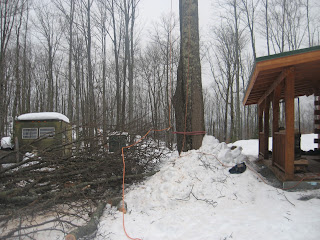Today we removed a twin-stem paper birch (Betula paperifera). It was growing next to an old shack near Sayner, WI. The stems were tall (about 50 ft.) and thick (about 14" dbh). I decided to use the GRCS to hang them in a red pine (Pinus resinosa). The process was as follows: First I had to install the pulley in the red pine. I installed a rope using throw line then installed a pulley on that line. I pulled the pulley up to the max height with throw line running through it so that I could still pull it down at any time. Once the pulley was installed I installed a winch line. I locked off the "pulley's down line" on a porta- wrap. This set up would allow me to use the height of the pulley to hang the birch stems. I now had a high pulley with a rigging line installed. My next step was to install the rigging line in the trees to be removed. I used throw line again to access a high branch union in each of the birch stems. I then installed the rigging line using a running bowline. I now had the rigging set up that I wanted which was a pulley that was higher than where the rigging line was installed on the birches. The rigging line was then pretensioned on the GRCS. This was so that the back lean of the birches would not cause the saw to get pinched. I made a 75-90 degree notch and bore-cut behind it leaving a FAT hinge (like two inches). I set up a trigger and walked over to the GRCS to crank the stems over. Finally, once the stems were hanging in the red pine, I cut the chunks off and lowered the stems till they were entirely on the ground. It was very controlled and I never had to get off of the ground to make it happen. What a great day! Here are pictures. I have video posted on my facebook page @ verticaltechniques. Enjoy the pictures and, if you make over to FB, the video.
Total Pageviews
Sunday, March 6, 2011
Saturday, March 5, 2011
Oak Removal near Hurley Wisconsin (scroll down for the description)
Yesterday Vertical Techniques did a take-down of a Red Oak (Quercus rubrum) near Hurley, WI. It was a beautiful day. The temps were in the high twenties and there was very little precipitation. We had to snowshoe into the job-sight which was on a hill. The drive-way had about two and a half feet of snow on it but it was crusty. The views from the top of the tree made me feel like we were closer to the Appalachian Mountain than Lake Superior. It was really beautiful up there. We did encounter a slight flurry for about an hour, but I didn't notice. Katy was my ground support. The tree was located on a hill and about five feet off of a hunting cabin. Due to the desire of the client to protect the cabin, a trailer and the surrounding trees, most of it had to be rigged down. I was happy to have my wife on the ropes as she great at rigging and very attentive to my needs as a climber. I used a 1/2 inch stable-braid rigging line and tailboard block along with a Rock-exotica mini-swivel pulley for my rigging set-up. We had a port-a-wrap set up on the base of the tree for friction control. We do have a GRCS (Good Rigging Control System) which is a Harken Nautical winch installed on a plate that can be used to lift limbs, but since we didn't need it, we didn't use it for that job. (I love my winch and would hate to crash a piece of wood on it unnecessarily). Due to the size of the drop zone, there was very little branch material that I was able to air-mail to the ground. Katy was fantastic on the rope. As I climbed I installed the main block as well as the redirect pulley. This allowed us to swing pieces that were growing over the house back into the drop zone. It worked well. The tree had two stems. I was able to rig out the branches of the smaller one and then snap-cuts on the wood to put it all in a pile in the drop zone. I then went back up and rigged the rest of the branches down into the drop zone. The pile of branches was substantial, but it was a good cushion for the wood. Once the top of the main-stem was down, I was then able to air-mail the wood. We left the trunk at about 12 feet so that the client could use it for access to the roof of the cabin. I advised him to use Round-up to kill the trunk, but the construction damage to the tree (soil-compaction as well as mechanical damage to the root flare) was severe. I don't believe that this tree was long for this world anyway. The buds seemed quite dry and most of them were even black. This dessication indicated that the tree was stressed at best. I note these conditions because I generally don't just leave trunks of living trees standing by structures if I believe that they will resprout and grow as that makes a future removal inevitable, and with a compromised structure, potentially dangerous. All in all it was great day. I hope you like the pictures...
Subscribe to:
Comments (Atom)







































